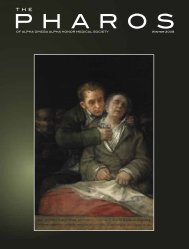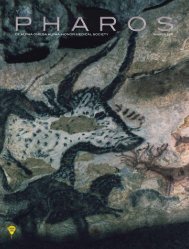The Pharos - Alpha Omega Alpha
The Pharos - Alpha Omega Alpha
The Pharos - Alpha Omega Alpha
You also want an ePaper? Increase the reach of your titles
YUMPU automatically turns print PDFs into web optimized ePapers that Google loves.
<strong>The</strong> making of a neurosurgeon<br />
<strong>The</strong> post-operative chart documentation is in Cushing’s<br />
handwriting, and indicates that he performed his own dressing<br />
changes. This is not surprising given Halsted’s expectations<br />
for the residents, 6,7 as well as Cushing’s own dissatisfaction<br />
with the surgical staff’s attention to detail. 1 Shortly after the<br />
operation, Cushing documented marked improvement in the<br />
patient’s condition: “Toes doing well —Been up and walking<br />
about for 48º [sic: minutes] s discomfort.” This rather simple<br />
procedure was Cushing’s second performance as a resident<br />
operating independently, and would certainly have been a<br />
source of pride for the young surgeon.<br />
Halsted was not the type of mentor to allow trainees to rest<br />
on their laurels. Cushing would have been expected to expand<br />
his experience to include increasingly complex cases, as well<br />
as schedule more time for surgery. On December 26, 1896,<br />
less than a month after his first experience as a lead surgeon,<br />
Cushing performed two separate operations, each significantly<br />
more complex than the preceding ones.<br />
On December 21, 1896, a twenty-three-year-old African<br />
American man presented with osteomyelitis at the lower end<br />
of his femur. Cushing operated on the patient on December 23,<br />
1896. His operative note describes the procedure:<br />
Incision 15 cm long over internal condyle and above.<br />
Sinus excised to point of entrance into bone. An opening at<br />
about site of adduction tubercle leads through about an inch<br />
and a half of eburnated periosteal (?) bone to a cavity in the<br />
end probably of the diaphysis. Here some dead bone can be<br />
felt. <strong>The</strong> sinus leading to it lined by flabby gray granulations.<br />
<strong>The</strong> bone chiseled away till would have held a hen’s egg.<br />
A flat sequestrum size diagram removed. Cavity curetted—<br />
irrigated with HgCl 2 . Iodaform powder introduced. Wound<br />
closed c silver over large blood clot. Dressing.<br />
<strong>The</strong>re appeared to be no extension of granulation along<br />
the medullary cavity, which in fact seemed completely<br />
walled off from the cavity . . . Apparently 4.5 cm of sclerosed<br />
bone chiseled through before reaching the sequestrum.<br />
<strong>The</strong> tone of the operative note, with its parenthetical question<br />
mark and conditional wording, may indicate self-doubt and a<br />
tendency to over-analyze, marking the transition from supervised<br />
resident to independent operator. In his later operative<br />
notes, Cushing continued to employ these occasional indicators<br />
of uncertainty, transforming the worries of a young resident<br />
into the hallmarks of a thorough and introspective attending<br />
surgeon. As Cushing matured as an attending, his operative<br />
notes reflected on similarities between the operation being<br />
conducted and other operative procedures. He referenced other<br />
cases where errors were made, and described his attempts to<br />
avoid those adverse outcomes in subsequent operations.<br />
Despite the doubts reflected in this early operative note,<br />
and the apparent amazement at the defect created intraoperatively,<br />
the patient had an uneventful post-operative<br />
course. His final outcome remains unknown, as on February<br />
6, 1897, following a forty-six-day hospital stay, the patient was<br />
“discharged by Dr. Hurd for bad conduct.” No details regarding<br />
the patient’s behavior were documented, and given the race<br />
of the patient in a segregated hospital in the South only a few<br />
years after the end of post-Civil War Reconstruction and the<br />
enactment of the Jim Crow laws, it is not possible to speculate<br />
profitably. From the post-operative documentation at the time<br />
of the patient’s discharge, Cushing would have seen the operation<br />
as a successful intervention.<br />
Cushing’s second case on December 23, 1896, had a very<br />
different outcome. <strong>The</strong> patient was a fifty-six-year-old African<br />
American man who presented with hemorrhoids on December<br />
16, 1896. <strong>The</strong> patient was brought to the operating room for<br />
what Cushing described as an “excision of unilateral prolapse<br />
of bowel. Whitehead method. Prolapse covered c verrucous<br />
growths.” Cushing’s operative note documents the procedure:<br />
Cushing’s original illustration of his excision of osteomyelitis of the femur during his internship year. <strong>The</strong> note in Cushing’s handwriting<br />
reads: “<strong>The</strong> bone chiseled away till would have held a hen’s egg.”<br />
Courtesy of the Medical Records Office and the Alan Mason Chesney Medical Archives of Johns Hopkins Institutions.<br />
12 <strong>The</strong> <strong>Pharos</strong>/Autumn 2012














